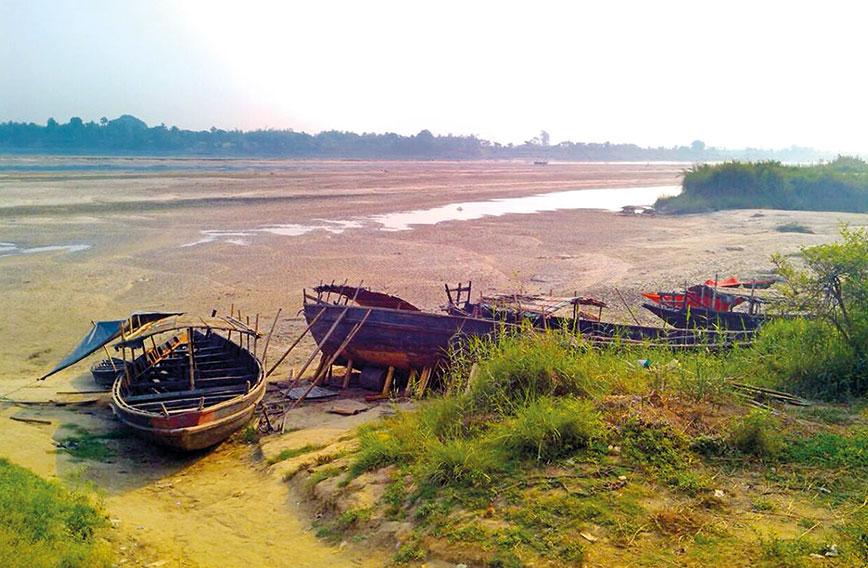
VENKATESH DUTTA
THE Ganga basin, the world’s most densely irrigated area, is a global hotspot of groundwater depletion. The five states through which the Ganga flows account for almost 40 percent of India’s total cultivated land. The basin has 360,000 square km of irrigated land or around 57 percent of India’s total net irrigated area. Groundwater is used to provide a large portion of this irrigation requirement. In reality, the transboundary Ganga basin accounts for one-fourth of total worldwide groundwater abstraction, with South Asia alone accounting for 48 percent of global groundwater consumption.
It is crucial to acknowledge that groundwater plays a key role in ensuring that all rivers retain their base flow even during the summer months. Groundwater, though hidden in the sub-surface, is essential for the survival of aquatic and terrestrial habitats. Local and regional groundwater resources are depleted when water withdrawal exceeds natural water recharge. Almost 90 percent of freshwater is utilized for irrigation globally, and groundwater pumping surpasses acceptable levels in India.
The dramatic decrease in river flows in recent years is a direct consequence of this. Even the flow of water in the Ganga is heavily dependent on the groundwater table, which is linked to long-lasting groundwater storage in the connected Gangetic aquifers. The impact of declining groundwater tables on river flows may be seen clearly in many tributaries of the Ganga which are witnessing significant reduction in their annual flows such as the Gomti, Ken, Betwa, Chambal, Narmada, and so on. Take, for example, the Gomti river basin — the percentage of land with post-monsoon water table over five metres was 91.45 percent in 1984, but it declined to 52.26 percent in 2006. Only 42 percent of the basin’s water table is higher than five metres today.
As a result, wetlands are becoming drier and rivers are becoming intermittent in flow. In the past 50 years, the flow of some tributaries of the Ganga has decreased by 30 to 60 percent. The decline in groundwater level and disconnect in base flow are two major reasons. Groundwater is a primary source of environmental flow in our rivers. As groundwater level drops, perennial rivers are turning seasonal. The Ganga basin’s continuous and long-term groundwater extraction has resulted in a sharp decline in the lean season flow. The river has low water levels in numerous lower segments such as at Allahabad and Varanasi and has a propensity to dry out through the summer.
Recent studies show that groundwater storage in the Ganga basin is rapidly declining and groundwater extraction at the current rate is totally unsustainable. Excessive canal diversions, river engineering with hard infrastructure and surface water abstraction are all contributing to the river’s diminishing flows. While we talk about yearly groundwater table declines of a few centimetres, in essence, excessive groundwater extraction might result in a constant large-scale mass loss over the whole basin in several cubic km. This can dry ecosystems and rivers that rely on groundwater. Recharging aquifers and efficient surface water management are critical for long-term water supply and ecosystem protection.
Let’s imagine the contribution of irrigation in our GDP. The Ganga basin accounts for almost 40 percent of India’s GDP, yet the significance of groundwater is either ignored or undervalued. Hydrating the economy by dehydrating rivers and aquifers will not work in the long run. Healthy rivers are signs of a healthy economy. We rely on our natural resources for our GDP. We may not be able to restore our degraded rivers even if we have enough money and physical resources. Over-extracting water from our rivers could damage the revitalizing forces that sustain these riverine ecosystems. Rapid economic development has resulted in a severe reduction in river health in India. It has influenced the myriad societal advantages that rivers offer free of cost, known as ‘ecosystem services’.
Over the next few decades, population expansion, urbanization, pollution and climate change, among other things, are predicted to strain these services. And this will have a cascading impact on our economy with diminished quality of life for people. Even though we rely on the bounty of rivers for our survival, at the same time we poison them, impede their flow, over-allocate their water into canals and dead channels, and degrade them in every manner possible. Due recognition of a river’s rights in our culture and society is yet to take place. We will eventually respect the fluvial memory and riverine landscapes and live in tandem
with the flow of the river for our own survival.
River restoration is becoming a typical strategy to counter deteriorating river health, and its significance in water resource management is only likely to expand in days to come. However, we should remember that only nature-based solutions will last. The resilience of concrete structures against the free spirit of rivers will be tested.
Cities and municipalities must safeguard their water sources and watersheds. All we have to do now is make sure we don’t infringe on the blue landscapes. The Ganga basin’s geo-hydrological boundaries are formed by aquifers, and not by administrative boundaries. Subsidies are fuelling groundwater exploitation. Night-time irrigation is triggered by off-peak power dumping. Farmers resort to flood irrigation with free power and free groundwater. The pricing signals do not accurately represent the societal and ecological value of groundwater. Due to the huge energy footprint of agricultural production, including irrigation, we need to come down to ‘crop per watt’ instead of ‘crop per drop’. In the face of climate change, we must also concentrate on adaptive governance where we can recharge in the event of flash floods and utilize the water that has been stored in the event of water scarcity.
Venkatesh Dutta is a Gomti River Waterkeeper and a professor of environmental sciences at Ambedkar University, Lucknow
Comments
-

W Vieira - July 11, 2022, 9:48 p.m.
There is so much, most of us don’t know about this subject. This article is an eye opener. How do we get more people to know about this? And this is important, if we are going to save the community and the country from disaster in the near future. This is a good starting point initiated as usual, by Civil Society!




